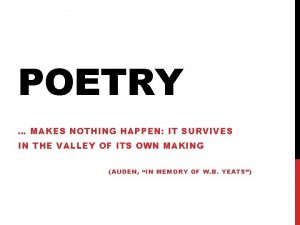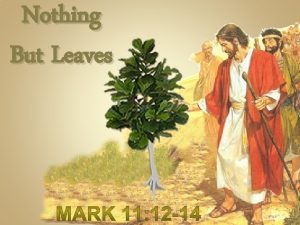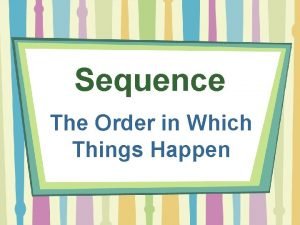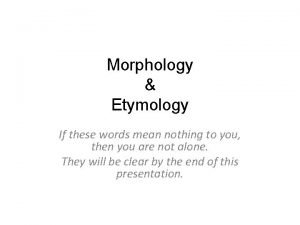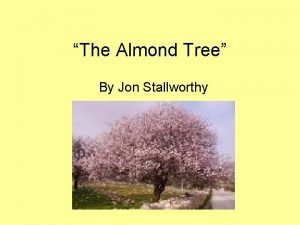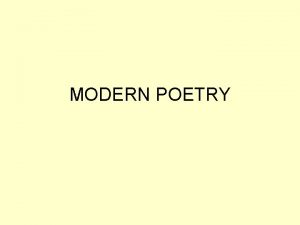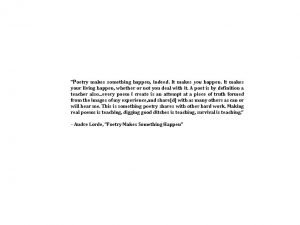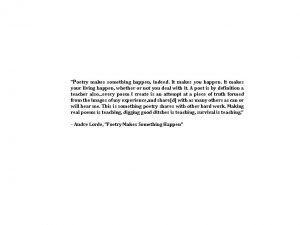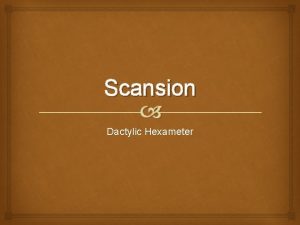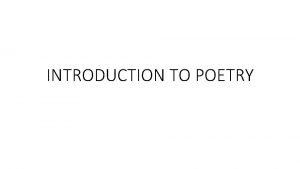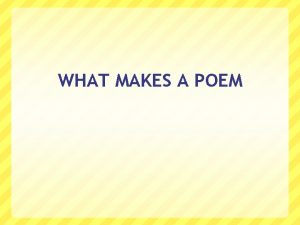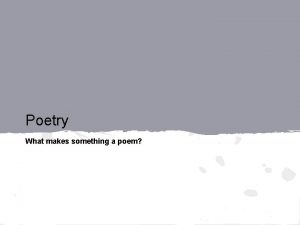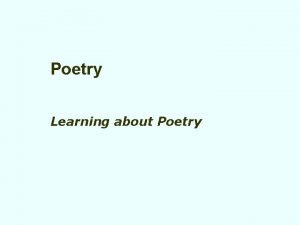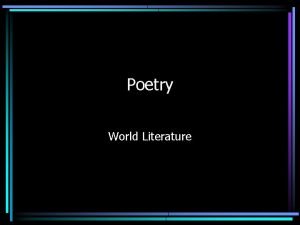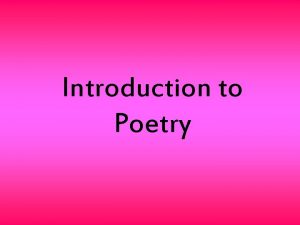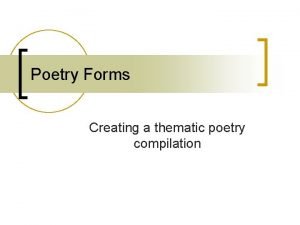POETRY MAKES NOTHING HAPPEN IT SURVIVES IN THE





























- Slides: 29

POETRY … MAKES NOTHING HAPPEN: IT SURVIVES IN THE VALLEY OF ITS OWN MAKING (AUDEN, “IN MEMORY OF W. B. YEATS”)

Cambridge English Practical Criticism Paper (2014): “Tipp-Ex Sonate”

WHAT COULD BE SAID? A better strategy would be to put Tipp-Ex Sonate in a wider aesthetic context. Students could discuss the avant-garde tradition of anti-art … Alternatively, a student could discuss the likes of EE Cummings, Charles Olson and Ezra Pound, all of whom used typographic trickery in their poems. […] It's also possible to see it as a memorial to the millions who died as a result of the last century's wars and despotisms - "a commemoration of the disappeared and the inadequacy of language", suggests Ford. In fact, according to Kombuis, a long-standing anti-apartheid activist, Tipp-Ex-Sonate was a protest against censorship laws imposed during white minority rule. "If you know about the historical and political context you could make sense of it as an inability to use a language that's tainted by apartheid, " says Ford. […] Some students must surely have been tempted to hand back their exam papers adorned only with punctuation of their own. (BBC)

WHAT IS POETRY ANALYSIS?

WHAT IS POETRY ANALYSIS?

HOW IS POETRY “SCULPTED”? “I wish our clever young poets would remember my homely definitions of prose and poetry; that is, prose, —words in their best order; poetry, —the best words in their best order. ” Samuel Taylor Coleridge

HOW DO I ANALYSE POETRY? 1. 2. 3. 4. Subject-matter: what is the poem about? Structure: what structural features are notable? Rhythm: how are the lines paced and stressed? Rhyme and other sound patterns

INDIVIDUAL AND SOCIETY Unseen text will definitely contain I&S themes; foreground these themes through your analyses (particularly in topic sentences)

Warsaw Uprising (1943)

“HISTORY” SUBJECT MATTER On the surface A schoolmaster leading his pupils through war-torn Warsaw. Related issues? Loss, destruction, dehumanisation (as a result of war), chaos …

“HISTORY” STRUCTURE Immediate observation of linguistic structure: one long sentence. Effect? - Prolonged action: “The schoolmaster … … …” – ok, what does he do? !? ! – “lead[s] his … twelve-year-olds” - This simple act, stated in one sentence, but presented as a poem, is thus charged with significance and emerges as an act containing several other acts.

“HISTORY” STRUCTURE Poetic form: free verse - Disconcerting? - The freedom of movement in this poetic form is limited by the fact that the poem is a sentence that marches towards its inevitable conclusion (// characters who march towards their inevitable deaths? ) - Deterministic?

“HISTORY” RHYTHM Enjambment and caesura: slowing the progression/pace of the poem – effect? - Commentary on the characters’ pacing through Warsaw: halting, interrupted, disorderly

“HISTORY” RHYME Absence of distinctive rhyme scheme - Disharmony, discord - Invitation to listen to other sound patterns in the poem.

“HISTORY” SOUND PATTERNS Poetic imagery of loss/destruction carpet slippers treading rubble of smashed cellars, […] glare of the burning street

“HISTORY” LANGUAGE Metonymy Enumeration of loss: - “bi-focals”, “pipe”, “tree-shaded study” … “and his wife Charlotte” – effect? - Why this list? - What is lost?

WHAT IS THE POEM “ABOUT”? 1. About the futility of resistance, 2. About despair in the face of this futility 3. About the fragility of humanity in the face of violence 4. A poem about the dehumanising force of war 5. About understated heroism 6. About the transformation of determinism to determination

“To live with honour and to die with honour”

Dietrich Bonhoeffer 4 Feb 1906 – 9 Apr 1945

“CHRISTMAS TREES” BY GEOFFREY HILL Subject Matter?

“CHRISTMAS TREES” RHYME - Three tercets; rhyme scheme: A 1 A 2 A 1 B 1 B 2 C 1 C 2 C 1 – effect? Clue: containment; resistance of containment

“CHRISTMAS TREES” RHYTHM - Regularity of syllables: 8 syllables per line, except for one – effect? - Some regularity of feet – effect?

“CHRISTMAS TREES” STRUCTURE - More end-stopped lines than enjambment – effect?

“CHRISTMAS TREES” STRUCTURE Structure invites interpretation - Stanza 1’s rhyme associates “cell” with “citadel” – metamorphosis and resistance - End-stopped lines suggest self-contained units – imprisonment or completeness? - “quiet” ironically stands out in line 8 – what do we hear? “We hear too late or not too late”

“CHRISTMAS TREES” LANGUAGE Ambivalence in language - “sacrifice”: for the anti-Nazi or Nazi cause? Or both? - Lines 8 -9: deliberately evasive? Ambivalence resists the state’s ability to fix the individual to a particular identity.

WHAT IS THIS POEM “ABOUT”? 1. About an individual’s resistance / subversion of the state’s power to signify / contain) 2. About the transformative power of Bonhoeffer’s sacrifice 3. About establishing order from chaos, turning discord into harmony

Individual and Society?

OTHELLO (2. 1. 179 -287) It gives me wonder great as my content To see you here before me. O my soul’s joy! If after every tempest come such calms, May the winds blow till they have wakened death And let the labouring bark climb hills of seas Olympus-high, and duck again as low As hell’s from heaven. If it were now to die, ‘Twere now to be most happy; for I fear My soul hath her content so absolute That not another comfort like to this Succeeds in unknown fate.

OTHELLO (2. 1. 179 -287) It gives me wonder great as my content – note meter and stress p. To see you here before me. O my soul’s joy! – note change in stress p. If after every tempest come such calms, May the winds blow till they have wakened death – note pace & stress p. And let the labouring bark climb hills of seas__ Olympus-high, and duck again as low As hell’s from heaven. If it were now to die, _ ‘Twere now to be most happy; for I fear – note change in stress p. My soul hath her content so absolute – note change in stress p. That not another comfort like to this Succeeds in unknown fate. – note line length and contrast to opening.
 Poetry makes nothing happen analysis
Poetry makes nothing happen analysis Nothing but leaves
Nothing but leaves The order in which things happen is called
The order in which things happen is called Words means nothing
Words means nothing Venture capital
Venture capital The way my mother speaks
The way my mother speaks The boy does nothing dance
The boy does nothing dance What makes poetry different than prose?
What makes poetry different than prose? What is poetry mean
What is poetry mean Augustan poetry vs romantic poetry
Augustan poetry vs romantic poetry Metaphysical poetry
Metaphysical poetry Poetry poetry
Poetry poetry Traditional poetry vs modern poetry
Traditional poetry vs modern poetry Lyrical poem
Lyrical poem Thơ thất ngôn tứ tuyệt đường luật
Thơ thất ngôn tứ tuyệt đường luật Phép trừ bù
Phép trừ bù Alleluia hat len nguoi oi
Alleluia hat len nguoi oi Hươu thường đẻ mỗi lứa mấy con
Hươu thường đẻ mỗi lứa mấy con đại từ thay thế
đại từ thay thế Vẽ hình chiếu vuông góc của vật thể sau
Vẽ hình chiếu vuông góc của vật thể sau Công của trọng lực
Công của trọng lực Tỉ lệ cơ thể trẻ em
Tỉ lệ cơ thể trẻ em Thế nào là mạng điện lắp đặt kiểu nổi
Thế nào là mạng điện lắp đặt kiểu nổi Lời thề hippocrates
Lời thề hippocrates Vẽ hình chiếu đứng bằng cạnh của vật thể
Vẽ hình chiếu đứng bằng cạnh của vật thể Quá trình desamine hóa có thể tạo ra
Quá trình desamine hóa có thể tạo ra Phản ứng thế ankan
Phản ứng thế ankan Môn thể thao bắt đầu bằng từ chạy
Môn thể thao bắt đầu bằng từ chạy Khi nào hổ con có thể sống độc lập
Khi nào hổ con có thể sống độc lập Dạng đột biến một nhiễm là
Dạng đột biến một nhiễm là
